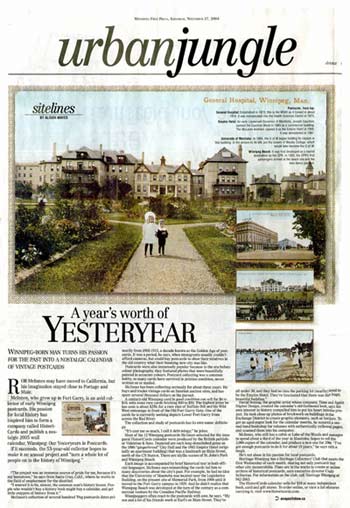





Print & Identity
Small Girl
Hub Computer
Dis-IT
Rainbow Point
Historicards 1
Logos 1
Logos 2
RR Stroll
VP-Net
Historicards 2
Cat Island Lodge
Invitations
Illustration
RX-Canada
St. John's Music
More samples...
Websites
Moore Bay
Sedentary Nomad
Rerick & Sons
CIL
RR Scooter
Amihude
Omniscreen
Clara Mitchell
BIg John's
More Samples...
Urban Jungle article from the Winnipeg Free Press, November 27, 2004.
WINNIPEG-BORN MAN TURNS HIS PASSION FOR THE PAST INTO A NOSTALGIC CALENDAR OF VINTAGE POSTCARDS. Rob McInnes may have moved to California, but his imagination stayed close to Portage and Main. McInnes, who grew up in Fort Garry, is an avid collector of early Winnipeg postcards. His passion for local history has inspired him to form a company called HistoriCards and publish a nostalgic 2005 wall calendar, Winnipeg: Our Yesteryears in Postcards. If it succeeds, the 53-year-old collector hopes to make it an annual project and "turn a whole lot of people on to the history of Winnipeg." "The project was an immense source of pride for me, because it's my hometown," he says from Santa Cruz, California, where he works in the field of employment for the disabled. |
||||
"I wanted it to be, almost, the common man's history lesson. People who wouldn't buy a history book might buy a calendar, and get little snippets of history from it." McInnes's collection of several hundred 'Peg postcards dates primarily from 1905-1915, a decade known as the Golden Age of postcards. It was a period, he says, when immigrants usually couldn't afford cameras, but could buy postcards to show their relatives in the old country what their booming new city was like. Postcards were also immensely popular because in the era before colour photography, they featured photos that were beautifully painted in accurate colours. Postcard collecting was a common hobby, so many cards have survived in pristine condition, never written on or mailed. McInnes has been collecting seriously for about three years. he buys and trades vintage cards on Internet auction sites, and has spent several thousand dollars on the pursuit. A century-old Winnipeg card in good condition can sell for $6 to $10, with some rare cards fetching $40-$50. The highest price he has seen is about $250, for a rare shot of Buffalo Bill and his Wild West entourage in front of the Old Fort Garry Gate. One of the cards he is currently seeking depicts Lower Fort Garry from across the Red River. The collection and study of postcards has its own name: deltiology. "It's cost me so much, I call it debt-iology," he jokes. Most of the 12 Winnipeg postcards McInnes selected for the inaugural HistoriCards calendar were produced by the British publisher Valentine & Sons. Depicted are such long-demolished gems as the 1886 "gingerbread' City Hall and the 1883 Empire Hotel (originally an apartment building) that was a landmark on Main Street, north of the CN Station. there are idyllic scenes of St. John's Park and Winnipeg Beach. Each image is accompanied by brief historical text in both official languages. McInnes says researching the cards led him to many discoveries about the city's past. For example, he had no idea that the University of Manitoba was located near the Legislative Building, on the present site of Memorial Park, from 1904 until it moved to the Fort Garry campus in 1929. And he didn't realize that Winnipeg Beach was developed at the turn of the century as a commercial venture by the Canadian Pacific Railway. Winnipeggers often react to the postcards with awe, he says. "My son and a lot of his friends work at Earl's on Main Street. They're all under 30, and they had no idea the parking lot (nearby) used to be the Empire Hotel. They're fascinated that there was this huge, beautiful building." David Boning, the graphic artist whose company, Lab 4 Design, created the calendar's old-fashioned look, says his own interest in history compelled him to put his heart into the project. He took close-up photos of brickwork on buildings in the Exchange District to create graphic elements, such as borders. To get an aged-paper look for the calendar months, he scoured a second-hand bookshop for volumes with authentically yellowed pages and scanned them into his computer. McInnes, who still has a cabin at Lake of the Woods and manages to spend about a third of the year in Manitoba, hopes to sell the 3,000 copies of the calendar, and produce a new one for 2006. "I've got enough postcards to do it for about 15 years," he says with a laugh. He' s not alone in his passion for local postcards. Heritage Winnipeg has a Heritage Collectors' Club that meets the first Wednesday of each month, sharing not only postcards but other city memorabilia. Plans are in the works to create an online archive of historical postcards, says executive director Cindy Sciberras. For information on the club, call Heritage Winnipeg at 942-2663. The Historicards calendar sells for $18 at many independent book, card and gift stores. To order online, or view a a list of stores carrying it, visit www.historicards.com. |
||||
